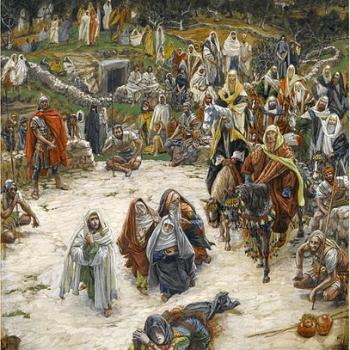One of the Apostle Paul’s repeated sayings is for believers to walk in the Spirit:
Romans 6:4: “Consequently, we were buried with him through the baptism into his death, so that just as Christ was raised from the dead through the glory of the Father, so also we might walk in a newness of life.”
Romans 8:4, 14: “So that the righteous requirement of the Law might be fulfilled in us, the ones who walk not in accordance with the flesh but in accordance with the Spirit… for as many as our led by the Spirit of God, these are sons and daughters of God.”
Galatians 5:16, 18, 25: “So I say, walk in the Spirit and you will not carry out the desires of the flesh… but if you are led by the Spirit, you are not under the Law… If we live in the Spirit, lets us keep in step with the Spirit” (Gal 5:16, 18, 25).
The last of these quotes in fact commands believers to walk in the Holy Spirit. This is not an option but requirement. If followers of Christ want to gain the upper hand over the desires of their sinful nature (“the flesh”), they are to “walk in,” be “led by,” and “keep in step” with the Spirit. So how do we appropriate this imperative? 
What it means to “Walk” in the Bible?
The notion of walking (περιπατέω/peripateo) is a metaphor for daily living. Paul may have originally derived the metaphor from Jewish halakha (derived from the Hebrew word “to walk” הלך). This has to do with oral precepts developed for helping people observe and live in the ways of the Torah (the Law of Moses).
The Old Testament uses the metaphor to refer to walking before the Lord (Gen 17:2; 24:40), walking with God (Gen 5:22; 6:9), walking blamelessly and with integrity (1 King 8:36; Ps 84:12; Isa 57:2), and walking in the ways of the Lord so as to keep his commandments (Deut 8:6; Josh 22:5; Jer 15:6).[1]
Additionally, the idea of walking in a path, course, way, etc., is prominent in Jewish wisdom literature, particularly Proverbs. Here the metaphor of walking includes conducting oneself with wisdom in relation to the virtues—to walk in the way of righteousness, integrity, and truth (e.g., Prov 2:7–9; 3:23; 8:20; 10:9; 13:20;14:2; 19:1; 20:7; 28:6, 18).[2]
Paul, however, did not require his mostly gentile audiences to become advocates of Moses’s Law (e.g., Gal 2:16–21). Rather than walking in the ways of the Torah, he charges believers to walk in the Holy Spirit. This is the way these uncircumcised believers can please God without keeping the Law. His perspective resembles the type of walking we find in Proverbs—walking in righteousness and godly virtues. But there is a difference—for the Christ followers, God’s Spirit will empower them in their walk.
Paul on the Concept of “Walking”
Paul uses the metaphor of walking numerous times in his letters. It is found in both his undisputed or disputed letters:
- walk in Christ (Col 2:6)
- walk in decency (Rom 13:13; 1 Thess 4:12)
- walk according to love (Rom 14:15; Eph 5:2)
- walk according to faith (2 Cor 5:7)
- walk worthy of God (1 Thess 2:12; Col 1:10; Eph 4:1)
- walk to please God (1 Thess 4:1; Col 1:10)
- walk in spiritual accordance with others (2 Cor 12:18)
- walk in one’s respective calling (1 Cor 7:17)
- walk after Paul’s own example (Phil 3:17)
- walk in wisdom (Col 4:5)
- walk in good works (Eph 2:10)
- walk carefully (Eph 5:15)
- walk as children of light (Eph 5:8)
- and of course, walk in the Spirit (Rom 8:4; Gal 5:16)
In essence, to “walk” in these various ways—that is, to conduct oneself on a regular basis in these ways—is part of what it is to be led by God’s Spirit. The context of each of these ways of walking will need to be explored for a better understanding of the respective phrases. For example, walking to “please God” in the context of 1 Thessalonians 4 includes holy living (sanctification) and abstinence from fornication, among other things.
None of this takes place by proverbially “pulling ourselves up by our own boot straps.” Doubtless, part of what it is to walk in the Spirit is to rely on the Spirit’s empowering abilities rather than our own.
Now that we understand a little bit about the metaphor of walking, what are some practical ways that believers today might actually “walk” in the Spirit based on Paul letters? Here are seven of them:
Seven Ways to Walk in the Spirit
- Praying in the Spirit. The Spirit is present with praying believers (Rom 8:26; Eph 6:18).

- Grow in the fruits of the Spirit. Grow in godly virtues such as love, joy, peace, patience, kindness, self-control, etc. (Gal 5:22-26; cf. 5:16).
- If love is the foremost fruit of the Spirit, then loving God and loving one’s neighbor must also be implied (Rom 12:9-10; 13:8-10; 1 Cor 8:2b-3; 13:1-13; Gal 5:14; cf. Matt 22:37-40).
- Since the new covenant is intricately connected with the Spirit (2 Cor 3), then commemoration of Jesus’s establishment of the new covenant at the Lord’s Supper (Eucharist, Holy Communion) is important to celebrate. This is especially the case since Jesus commanded his followers, “do this… in remembrance of me” (1 Cor 11:25). This also means, incidentally, that you should be going to church.
- Operate in one’s gifts of the Spirit to edify others (Rom 12:3-8; 1 Cor 12, 14). Edifying one another happens by congregating together, where one hears the word of God through the preaching and hearing of Scripture. This, too, means that you should be going to church or otherwise gathering with a group of believers for routine edification. Unlike the first-century church, though, not only can we hear the word of God at church, but we are able also to own our own Bibles and read them at home for personal devotion and edification.
- Worshipping, praising, and singing together with other believers is said in tandem with being filled with the Spirit (Eph 5:18-21).
- Believers will want to “walk” in the Spirit by keeping all the relevant imperatives that are found in the New Testament. A great example is Paul in Romans 6:11-22. Here Paul’s imperatives include, for example, living with a perception of being dead to sin and alive in Christ. Also, believers are to present before God their bodily members (i.e., your eyes, hands, feet, genitals, etc.) as weapons of righteousness.
Notes
[1] On these points, see especially, Robert Banks, “‘Walking’ as a Metaphor of the Christian Life: The Origins of a Significant Pauline Usage,” in Perspectives on Language and Text: Essays and Poems in Honor of Francis I. Andersen’s Sixtieth Birthday July 28, 1985 (Winnona Lake, IN: Eisenbrauns, 1987), 303–13, esp. 305.
[2] See Andrew E. Steinmann and Michael Eschelbach, “Walk This Way: A Theme from Proverbs Reflected and Extended in Paul’s Letters,” Concordia Theological Quarterly 70 (2006): 43-62.
Image 1: Sand Foot Prints Walking Footprints Ocean via pixabay.com; Image 2: Dove Cross Hands Fire God Trinity Holy Triune via pixabay.com
















